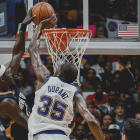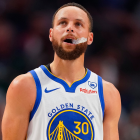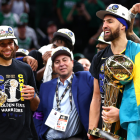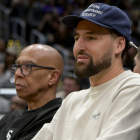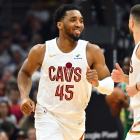Today marks an exact month since the start of the NBA season, and there has been no shortage of story lines around the league.
The most exciting part of the early season, however, is sorting out the wild statistical anomalies that pop up -- great teams play poorly, great shooters can't make shots, bad defenders play great defense. There's always something, and in general they even out over the course of the year.
But some stats are too crazy to just ignore. Some are so mind-boggling that you just have to take an extra look and say, wait, this can't be for real, can it? That's exactly what we've done here, as we've examined the most surprising statistics from the first month of the NBA season to see whether they can be sustained throughout the entire year.
Be sure to check back in April, when all's said and done. Things will probably look much different.
28.9 points per game
Why is it surprising? We all knew Porzingis, who averaged 18.1 points per game last season, would take on the bulk of the Knicks' scoring load this season without Carmelo Anthony, but we thought it would at least take him until mid-season to find his groove. Instead the 7-foot-3 unicorn came out of the box looking like a future Hall of Famer, and has already put up eight games of 30 or more points after doing it just three times in his first two seasons in the NBA.
Is it sustainable? Absolutely. Averaging close to 30 points in the NBA is no easy feat, but there are signs that make you think Porzingis will be able to do it. One is that his usage rate is second to only James Harden, and despite the high volume, Porzingis has remained wildly efficient with a 59.2 true shooting percentage, including 40.6 percent on 3-pointers.
Players like Tim Hardaway Jr. and Courtney Lee have been able to space the floor enough for him to operate at the elbow, where he's averaged a remarkable .788 points per touch, largely because of his ability to simply turn and shoot over smaller defenders.
50 percent on 3-pointers
Why is it surprising? If you predicted this summer that Aaron Gordon would be third in the NBA in 3-point percentage a month into the season, give yourself a pat on the back. Gordon shot 29 percent on 3-pointers in his first three seasons in the NBA on 2.2 attempts per game -- this year he's shooting 50 percent on 4.6 attempts per game. Simply a staggering improvement.
Is it sustainable? Obviously he's not going to shoot 50 percent for the rest of the year, but if he fell to 40 percent, it would still be considered a miraculous change. Even that seems doubtful, however, since according to NBA.com player tracking, 45 of Gordon's 60 3-point attempts have been of the "wide open" variety (closest defender six or more feet away), and he's shooting 57.8 percent on those. Steph Curry, probably the best shooter in the world, only shot 46 percent on wide open 3s last season, so Gordon's percentage is bound to come down.
The other factor is that teams will start closing on him a bit harder and generally be more aware of his presence outside the paint now that he's proved he can hit the deep ball consistently. So looks like this one, where Rondae Hollis-Jefferson expects Gordon to remain near the paint as he drifts to the 3-point line, will become few and far between.
2.2 blocks per game
Why is it surprising? Durant averaged 1.6 blocks per game as the Warriors' rim protector last season, but 2.2 is legitimate elite shot-blocker status, right up there with Rudy Gobert and Anthony Davis. If he stays at that number, he'll likely end up among the top three shot blockers in the NBA by season's end.
Is it sustainable? Yes. Durant has already won an MVP, a championship and a Finals MVP. He's committed himself to defense in the latter part of his prime, and there's no reason to believe his elite rim protection won't continue given his length and athleticism. The Warriors are also so quick and sound defensively that Durant can afford to take chances with off-ball block attempts, knowing his teammates will rotate and cover for him -- like here, when he runs damn near all the way across to court to help Patrick McCaw in the post.
 Philadelphia 76ers
Philadelphia 76ers
26.4 assists per game
Why is it surprising? Two seasons ago the 76ers were 20th in the league in assists. Last year, they moved up to eighth, and now they're second -- right behind the Warriors, who have led the league in the category since the 2014-15 season. The Sixers also lead the league in passes per game.
Is it sustainable? Definitely. Coach Brett Brown continually preaches the importance of passing the ball, and has admitted to emulating the Warriors' style of play. Having a 6-foot-10 point guard who's a willing passer makes sharing the ball that much easier. The Sixers also lead the league in turnovers, so Brown is clearly willing to sacrifice giving the ball away occasionally to keep the passing game going.
63.1 percent free throws
Why is it surprising? Coming into this season, Drummond was one of the worst free throw shooters in NBA history at 38 percent. This season he's nearly doubled that, and even went 14-for-16 from the line in a game against the Milwaukee Bucks earlier this year.
Is it sustainable? Yes. Drummond will still have the occasional dud (0-for-7 against the Pacers in Nov. 8), but our very own James Herbert detailed how the big man has totally revamped his free throw regimen both mentally and physically. He'll likely never be an 80 percent shooter, but hovering around 60 is a definite possibility as the Pistons aim for a top-five playoff seed.
 Boston Celtics
Boston Celtics
95.4 defensive rating
Why is it surprising? The Celtics were good defensively last season, but this season they've been other-worldly with the best defensive rating in the NBA. They've also done this with Kyrie Irving, a suspect defender at best, on the court with Jayson Tatum, a rookie, and no real shot-blocking presence. It even worked in a win Thursday against the Warriors. Brad Stevens, you genius.
Is it sustainable? Probably not. The Celtics will likely continue to be a very good defensive team, but 95.4 is a joke. No team has finished with a defensive rating that low since the 2011-12 Chicago Bulls (95.3), and the Celtics aren't going to finish the season with an 80-2 record ... at least we think they won't. There are bound to be some defensive stinkers in there to throw a wrench in the rating.
38.1 minutes per game
Why is it surprising? I mean, come on. One of these days, LeBron is going to have to slow down, right? He led the league in minutes last year and now, in his 15th season, he's doing it again.
Is it sustainable? Frighteningly, yes. The logical answer would be no, but the Cavaliers have been anything but logical about LeBron's minutes over the last couple of seasons. Add to the equation the Cavs' early-season struggles and the fact that if they don't live up to their lofty expectations, LeBron could potentially leave Cleveland once again, and there might be a lot of minutes in LeBron's future. LeBron has proven to be one of the most durable athletes in sports history, and he'll have to keep it up this season.
 Oklahoma City Thunder
Oklahoma City Thunder
160.0 clutch defensive rating
Why is it surprising? It looks like a typo, but it's not. The Thunder's struggles in clutch time (game within five points with five minutes left) have been astronomically atrocious, and they've gone 1-6 in those type of contests. We know Russell Westbrook and Carmelo Anthony aren't the best defenders in the world, but this is absurd. They're a vastly different team, but last season the Thunder's clutch defensive rating was second in the league at 96.8.
Is it sustainable? Let's hope not. Our Matt Moore broke down the Thunder's late-game horror show and what they need to do to fix it. The Lakers had the worst clutch defensive rating last season at 125.1, so 160 for an entire season is unimaginable, particularly for a team as good as the Thunder.



















